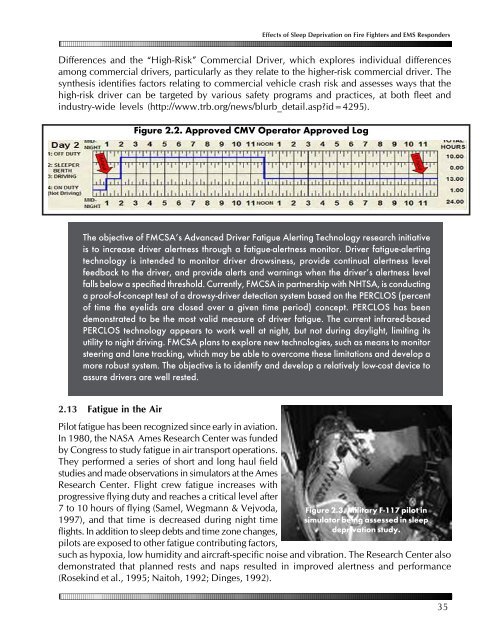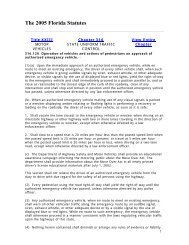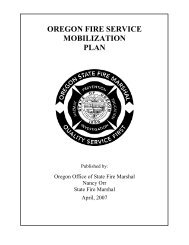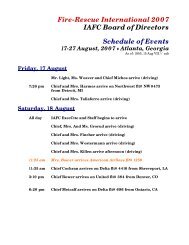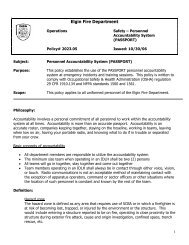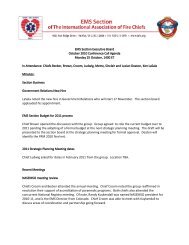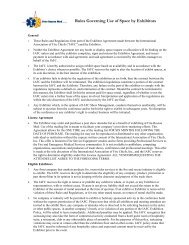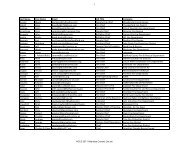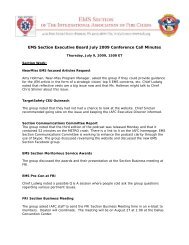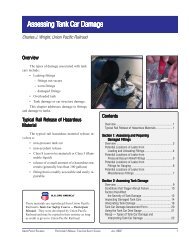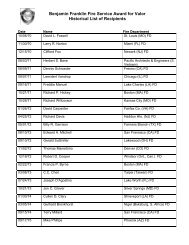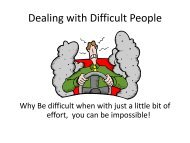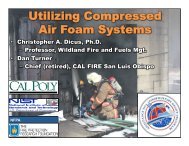Effects of Sleep Deprivation on Fire Fighters and EMS ... - NAEMT
Effects of Sleep Deprivation on Fire Fighters and EMS ... - NAEMT
Effects of Sleep Deprivation on Fire Fighters and EMS ... - NAEMT
Create successful ePaper yourself
Turn your PDF publications into a flip-book with our unique Google optimized e-Paper software.
<str<strong>on</strong>g>Effects</str<strong>on</strong>g> <str<strong>on</strong>g>of</str<strong>on</strong>g> <str<strong>on</strong>g>Sleep</str<strong>on</strong>g> <str<strong>on</strong>g>Deprivati<strong>on</strong></str<strong>on</strong>g> <strong>on</strong> <strong>Fire</strong> <strong>Fighters</strong> <strong>and</strong> <strong>EMS</strong> Resp<strong>on</strong>ders<br />
Differences <strong>and</strong> the “High-Risk” Commercial Driver, which explores individual differences<br />
am<strong>on</strong>g commercial drivers, particularly as they relate to the higher-risk commercial driver. The<br />
synthesis identifies factors relating to commercial vehicle crash risk <strong>and</strong> assesses ways that the<br />
high-risk driver can be targeted by various safety programs <strong>and</strong> practices, at both fleet <strong>and</strong><br />
industry-wide levels (http://www.trb.org/news/blurb_detail.asp?id=4295).<br />
Figure 2.2. Approved CMV Operator Approved Log<br />
The objective <str<strong>on</strong>g>of</str<strong>on</strong>g> FMCSA’s Advanced Driver Fatigue Alerting Technology research initiative<br />
is to increase driver alertness through a fatigue-alertness m<strong>on</strong>itor. Driver fatigue-alerting<br />
technology is intended to m<strong>on</strong>itor driver drowsiness, provide c<strong>on</strong>tinual alertness level<br />
feedback to the driver, <strong>and</strong> provide alerts <strong>and</strong> warnings when the driver’s alertness level<br />
falls below a specified threshold. Currently, FMCSA in partnership with NHTSA, is c<strong>on</strong>ducting<br />
a pro<str<strong>on</strong>g>of</str<strong>on</strong>g>-<str<strong>on</strong>g>of</str<strong>on</strong>g>-c<strong>on</strong>cept test <str<strong>on</strong>g>of</str<strong>on</strong>g> a drowsy-driver detecti<strong>on</strong> system based <strong>on</strong> the PERCLOS (percent<br />
<str<strong>on</strong>g>of</str<strong>on</strong>g> time the eyelids are closed over a given time period) c<strong>on</strong>cept. PERCLOS has been<br />
dem<strong>on</strong>strated to be the most valid measure <str<strong>on</strong>g>of</str<strong>on</strong>g> driver fatigue. The current infrared-based<br />
PERCLOS technology appears to work well at night, but not during daylight, limiting its<br />
utility to night driving. FMCSA plans to explore new technologies, such as means to m<strong>on</strong>itor<br />
steering <strong>and</strong> lane tracking, which may be able to overcome these limitati<strong>on</strong>s <strong>and</strong> develop a<br />
more robust system. The objective is to identify <strong>and</strong> develop a relatively low-cost device to<br />
assure drivers are well rested.<br />
2.13 Fatigue in the Air<br />
Pilot fatigue has been recognized since early in aviati<strong>on</strong>.<br />
In 1980, the NASA Ames Research Center was funded<br />
by C<strong>on</strong>gress to study fatigue in air transport operati<strong>on</strong>s.<br />
They performed a series <str<strong>on</strong>g>of</str<strong>on</strong>g> short <strong>and</strong> l<strong>on</strong>g haul field<br />
studies <strong>and</strong> made observati<strong>on</strong>s in simulators at the Ames<br />
Research Center. Flight crew fatigue increases with<br />
progressive flying duty <strong>and</strong> reaches a critical level after<br />
7 to 10 hours <str<strong>on</strong>g>of</str<strong>on</strong>g> flying (Samel, Wegmann & Vejvoda,<br />
1997), <strong>and</strong> that time is decreased during night time<br />
flights. In additi<strong>on</strong> to sleep debts <strong>and</strong> time z<strong>on</strong>e changes,<br />
pilots are exposed to other fatigue c<strong>on</strong>tributing factors,<br />
Figure 2.3. Military F-117 pilot in<br />
simulator being assessed in sleep<br />
deprivati<strong>on</strong> study.<br />
such as hypoxia, low humidity <strong>and</strong> aircraft-specific noise <strong>and</strong> vibrati<strong>on</strong>. The Research Center also<br />
dem<strong>on</strong>strated that planned rests <strong>and</strong> naps resulted in improved alertness <strong>and</strong> performance<br />
(Rosekind et al., 1995; Naitoh, 1992; Dinges, 1992).<br />
35


